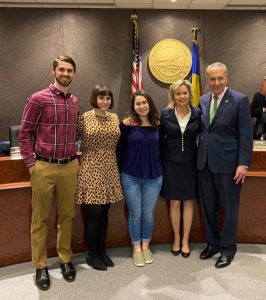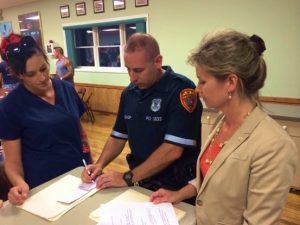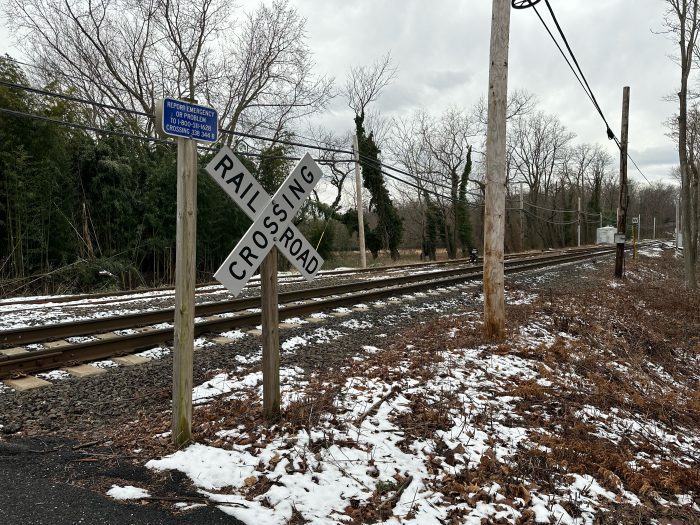By Gavin Scarlatos
After 12 years of service, Suffolk County Legislator Sarah Anker (D-Mount Sinai) is stepping down due to term limits. Anker entered office in 2012 with an objective to improve the lives of Suffolk County residents. Throughout her tenure, she tackled a wide range of issues, focusing on public safety, infrastructure, protecting the environment and community well-being.

Anker represented the 6th Legislative District spanning over much of the northeast portion of the Town of Brookhaven, including the hamlets of Miller Place, Sound Beach, Shoreham, Rocky Point and parts of Mount Sinai, Ridge, Middle Island, Coram and Wading River. Her work within her district exemplifies how she prided herself on providing a voice for her constituents to be heard.
“I hope that folks appreciate not so much what I’ve been able to accomplish, but what they have been able to accomplish working with me and working with my colleagues,” Anker said.
Throughout her career in public service Anker has tackled issues from environmental preservation to fighting the opioid epidemic, all the while looking to decrease government spending and placing emphasis on the overall quality of life for Suffolk County residents.
“Many of my legislative initiatives have focused on public safety, from addressing our dangerous roads to going after drug dealers who have contributed to the opioid epidemic,” Anker said.
One of her most notable achievements in tackling public safety concerns was developing the North Shore Rail Trail, providing pedestrians and bicyclists a safer outlet where they can avoid traffic while also giving the community a place to connect to the environment.
“I spearheaded the North Shore Rail Trail, a 10-mile recreation path from Mount Sinai to Wading River, that provides a safer alternative for walking, jogging, running and biking,” she said. “The path links the communities together and provides economic support for local businesses.”
Much of Anker’s work centered around the quality of life for her district’s residents and throughout her career she has proved to be a proponent for improving road safety.
“Road safety has always been one of my top priorities,” Anker said. “The number one complaint in my office throughout the years has been potholes, not surprisingly. With both NYS Route 25 and NYS Route 25A going through my district, I continued to advocate to all levels of government to fix and repair our dangerous roads.”
In her mission to enhance local roads and address traffic incidents, Anker worked with authorities to increase the number of patrolling traffic safety officials and to implement and improve existing traffic signage.

“I’ve been successful with adding additional lights and signage including a red light at Ridge Road, increasing the number of crossing guards near schools and producing the School Traffic Zone Safety Report to identify problem traffic areas,” she added.
Before serving in the Legislature, Anker had been energy director for the Town of Brookhaven, where she developed solar programs and promoted clean energy and green homes technologies. She had also served on the Mount Sinai school board, raising three children in the district. Anker took it upon herself to find solutions to the problems afflicting her community, utilizing the care and problem-solving skills that come with being a working mother.
“I became involved in the political space — this is going back to the 1980s — because I noticed that there were some water quality issues,” Anker said. “I became aware of environmental issues within the area and while raising my three children, I was concerned about their exposure to environmental contaminants.”
After Anker’s grandmother lost her battle to breast cancer, the granddaughter founded the not-for-profit Community Health and Environment Coalition and led the organization to raise awareness about how our environment directly impacts our health.
After years of being a community leader and getting results, Anker decided to run for Suffolk County legislator in 2011 with the goal in mind to better help people and lead important initiatives. As a legislator, Anker often prioritized people over politics.
“It’s something to be proud of — Heritage Park [in Mount Sinai], the North Shore Rail Trail, traffic improvement and public safety,” she said. “Makes me think of all the neighborhood watches that we created in Rocky Point, Miller Place and Sound Beach. And the acquisition of open space, the cleaning up of the water, the farmland preservation. We did a lot.”
Looking ahead while out of office, Anker hopes to continue helping people and working with the community to resolve problems. She has taken a position at the Board of Elections where she will use the skills she acquired running successful campaigns to ensure a fair and just voting process.
Anker will also be completing projects outside the realm of politics. She plans to follow up her previous award-winning publications with her third children’s book, this one, focused around overcoming adversity and appreciating the environment.
Though Anker’s years of public service as a legislator have come to an end, she has left an indelible mark on the community and plans to continue finding solutions to the issues affecting those around her by bringing people together.
After 12 years of serving the community as county legislator, Anker advocates for more residents to get involved in their local government.
“When you help people, you really feel the good that you’re doing,” Anker said. “This type of feeling just passes on to the next person and hopefully it continues. If everybody could do this, the world would be a much better place.”
















